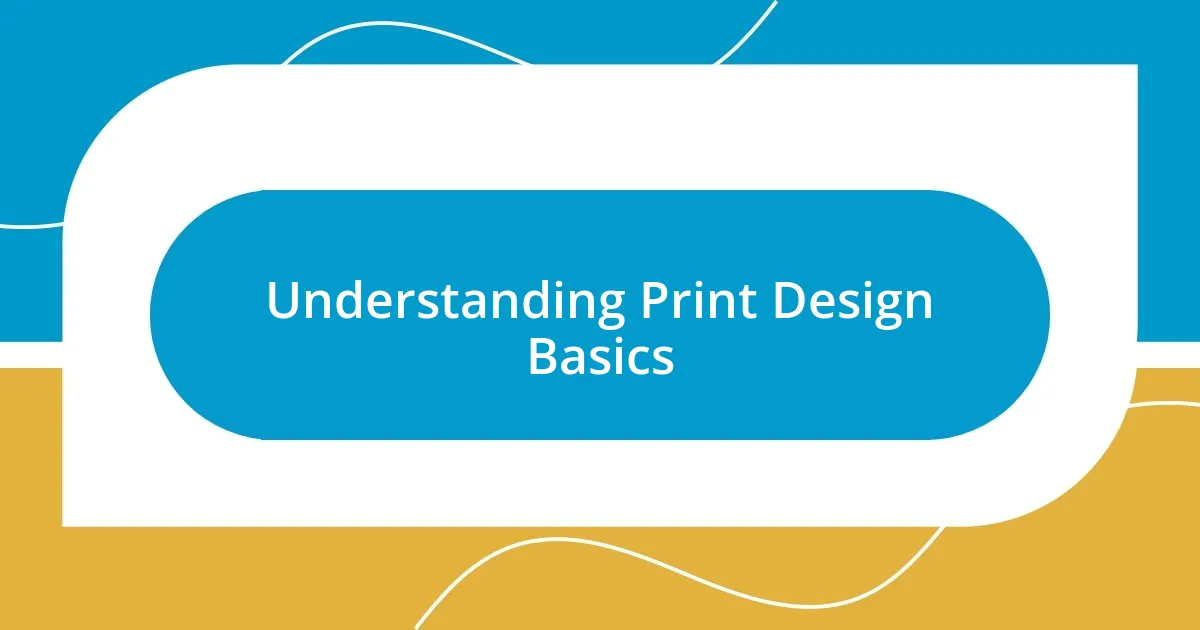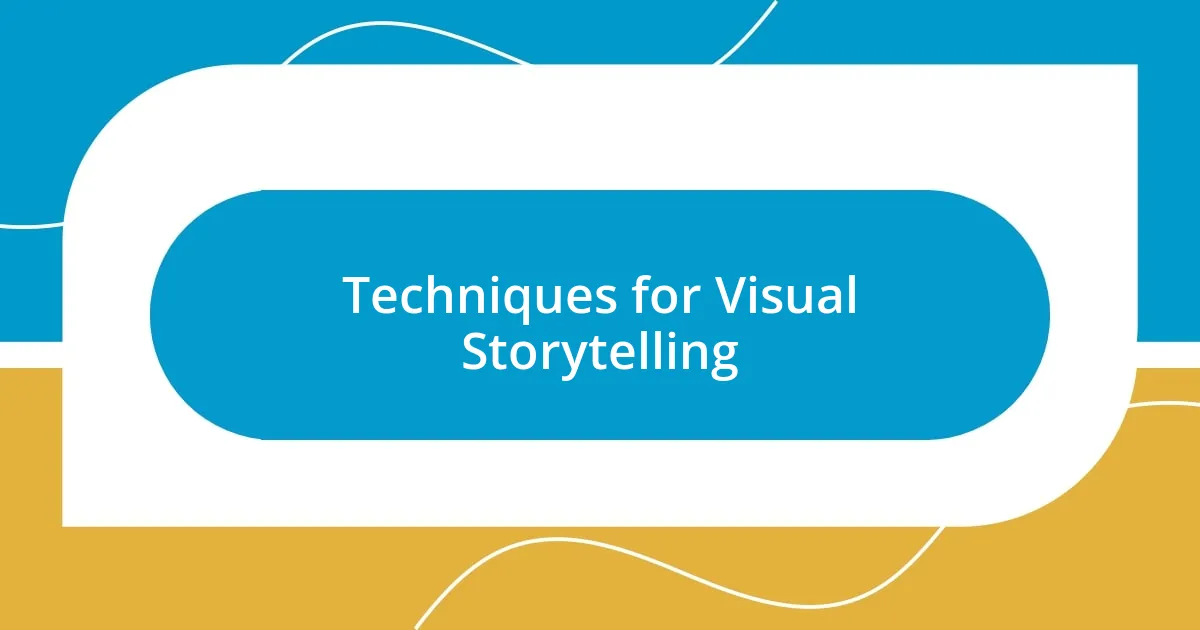Key takeaways:
- Effective print design balances visuals, typography, and space to guide reader experience and evoke emotions.
- Storytelling in print creates emotional connections and enhances reader engagement, transforming information into immersive narratives.
- Visual storytelling techniques include using impactful imagery, strategic typography, and pacing with white space to shape reader experience.
- Choosing appropriate typography and imagery is crucial for conveying the intended emotional tone and ensuring readability and resonance with the audience.

Understanding Print Design Basics
Print design is more than just pretty layouts; it’s a careful balance of visuals, typography, and space that guides the reader’s experience. I remember the first time I held a beautifully designed brochure. The way the colors complemented each other and the typography flowed made me feel like I was on a journey. Have you ever noticed how certain designs evoke emotions even before you read a single word? That’s the magic of intentional print design.
One of the fundamentals that I often emphasize is the importance of hierarchy in design. This means organizing elements so that the eye naturally flows from one point to the next. I learned this first-hand when I made a poster for a local event; the feedback I received highlighted how the clear headings and visuals drew people in. It’s fascinating how a simple adjustment in layout can transform an average piece into something compelling, don’t you think?
Color theory is another essential concept that shapes print design. Choosing the right colors can create empathy and connection or, conversely, cause confusion. I once experimented with a monochromatic palette for a small magazine project, and I found that it created a cohesive yet unexpected feel. Have you ever played with colors in your designs? It’s like telling a story; each hue has its own character and emotion.

Exploring the Importance of Storytelling
Storytelling is a powerful tool that allows us to connect on a deeper level. I vividly remember flipping through a well-crafted narrative magazine that seemed to pull me in. Each page turned was like unlocking a new chapter, making me feel part of the story. This immersive experience isn’t just by chance; it’s the intentional design that lays the foundation for storytelling. It transforms information into a journey where readers can relate to characters, challenges, and resolutions.
- Storytelling creates emotional connections, allowing readers to feel invested in the narrative.
- It encourages empathy by presenting different perspectives, helping us understand experiences beyond our own.
- A well-told story often lingers in the mind, leading to more memorable and impactful experiences.
- It fosters engagement, keeping readers intrigued and eager to learn more.
Harnessing storytelling in print design can elevate a simple message into a lasting impression, painting an emotional landscape that resonates long after the page is turned. I think of a project I worked on where we used real-life testimonials; those heartfelt stories transformed our brochure from a mere marketing tool into a heartfelt call to action. It just goes to show how impactful storytelling can be in any medium.

Techniques for Visual Storytelling
Visual storytelling is all about how design elements come together to tell a compelling narrative. One technique I’ve found incredibly effective is the use of imagery to evoke certain emotions. For example, while working on a community awareness campaign, I opted for candid photographs that captured real moments from people’s lives. The raw authenticity of those images brought stories to life, immersing the viewer in the experience. Have you ever noticed how a single photograph can convey a thousand words? It’s a powerful reminder that visuals can often speak louder than text.
Another crucial aspect of visual storytelling is the interplay of typography and layout. I recall a project where I experimented with a dynamic mixture of bold and delicate fonts to create visual contrast. The juxtaposition drew attention and symbolically illustrated the clash of ideas we were discussing in the content. It’s fascinating how the right choice of font can dramatically enhance the narrative’s tone. What’s your experience with typography—do you find it easy to play with different styles to match your message?
Lastly, I believe pacing is a vital technique. Just as a storyteller varies the cadence of their voice, I learned that the rhythm of printed elements also shapes the reader’s experience. During a magazine project, I used strategic white space to create moments of pause, allowing readers to digest heavy information. These intentional breaks in the design felt like a breath of fresh air amid a sea of content. Have you tried incorporating pacing in your designs? It’s truly a game-changer for holding a reader’s attention.
| Technique | Description |
|---|---|
| Imagery | Using relevant, emotional photographs to enhance the narrative. |
| Typography | Mixing fonts strategically to create contrast and convey emotions. |
| Pacing | Utilizing white space for rhythm, allowing readers to process content. |

Choosing the Right Typography
Choosing the right typography is crucial in shaping the emotional tone of your printed story. I remember working on a children’s book where I chose playful, rounded fonts for the text. The moment I saw how the letters danced across the pages, I knew they perfectly matched the whimsical illustrations. Isn’t it amazing how certain fonts can transport you directly into a specific mood or setting?
Moreover, I’ve found that font combinations can create striking effects. During a campaign for a local art exhibit, I blended a classic serif with a modern sans-serif. The result? A beautiful contrast that drew attention and led the reader through the narrative in a seamless way. Have you ever experimented with mixing styles? You might find that the right pairing adds depth to your design, making your stories even more engaging.
As tempting as it may be to select visually striking fonts, readability should be a top priority. During a project for a health awareness brochure, I opted for a clean, legible typeface that worked for all ages. The feedback was overwhelmingly positive—people appreciated not having to squint at the text. Have you considered how your font choices affect accessibility? It’s a small detail that can have a big impact on how effectively your story is communicated.

Incorporating Imagery in Design
When incorporating imagery into design, I’ve discovered that the emotional weight of an image can transform a narrative. For instance, during a project about climate change, I chose striking landscapes paired with stark contrasts—showing both beauty and devastation. That decision was not casual; it was a deliberate effort to stir feelings of urgency and hope. Have you ever felt a profound connection to an issue just through a powerful image? It’s remarkable how visuals can ignite that spark.
In my experience, selecting the right imagery goes beyond aesthetics; it’s about resonance with your audience. While designing a brochure for a local charity, I opted for photos of volunteers engaged in heartfelt activities. Watching how those images captured the essence of community made me realize storytelling doesn’t just happen through words; it flourishes through visuals that truly represent the subject matter. What types of images resonate with you when you’re designing? Finding that connection can elevate your work.
I’ve learned that the placement of imagery is equally important as the images themselves. For a project focused on mental health awareness, I arranged images to guide the reader’s eye. By pairing evocative images on one side with compelling quotes on the opposite, I created a dialogue on the page. Did you know that strategic arrangement can enhance narrative flow? It’s like leading readers through an emotional journey, crafting an experience they won’t forget.














